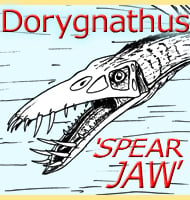In Depth
Georgiacetus is one of the most primitive whale genera to be discovered in the United States, with the holotype fossils discovered in the state of Georgia during the construction of a nuclear power station. New fossil material discovered in 2008 resulted in confirmation that Georgiacetus did not have a fluked tail like modern whale forms. This also means that Georgiacetus would have primarily swum with a combination of undulating the hips and trunk with the rear legs used for additional propulsion.
This in turn has caused a little bit of upset with traditional evolutionary models which had whales evolving in Asia, and then developing tail flukes which allowed them to cross oceans into new territories. The presence of Georgiacetus, without a tail fluke in North America proves that this was not entirely the case. However, this does not completely discount the idea of an Asian origin for whales, early populations were best adapted for coastal swimming anyway, and they could have spread across to North America simply by hugging the coast lines of India, China, and Russia, before passing along Beringia. Beringia is the name of the land bridge that once connected Eurasia and North America that allowed faunal exchanges to take place for tens of millions of years, but today this has been submerged to form the Bering Strait. It should also be remembered that during the Eocene North and South America were separated, and that once primitive whales reached Southern Mexico they would be able to keep swimming along to colonise the southern and eastern coastlines of North America.
Further Reading
- A new middle Eocene protocetid whale (Mammalia: Cetacea: Archaeoceti) and associated biota from Georgia. - Journal of Paleontology 72(5):907-927. - R. C. Hulbert, R. M. Petkewich, G. A. Bishop, D. Bukry & D. P. Aleshire - 1998. - New Protocetid Whales from Alabama and Mississippi, and a New Cetacean Clade, Pelagiceti. - Journal of Vertebrate Paleontology 28 (3): 589–593. - Mark D. Uhen - 2008.









